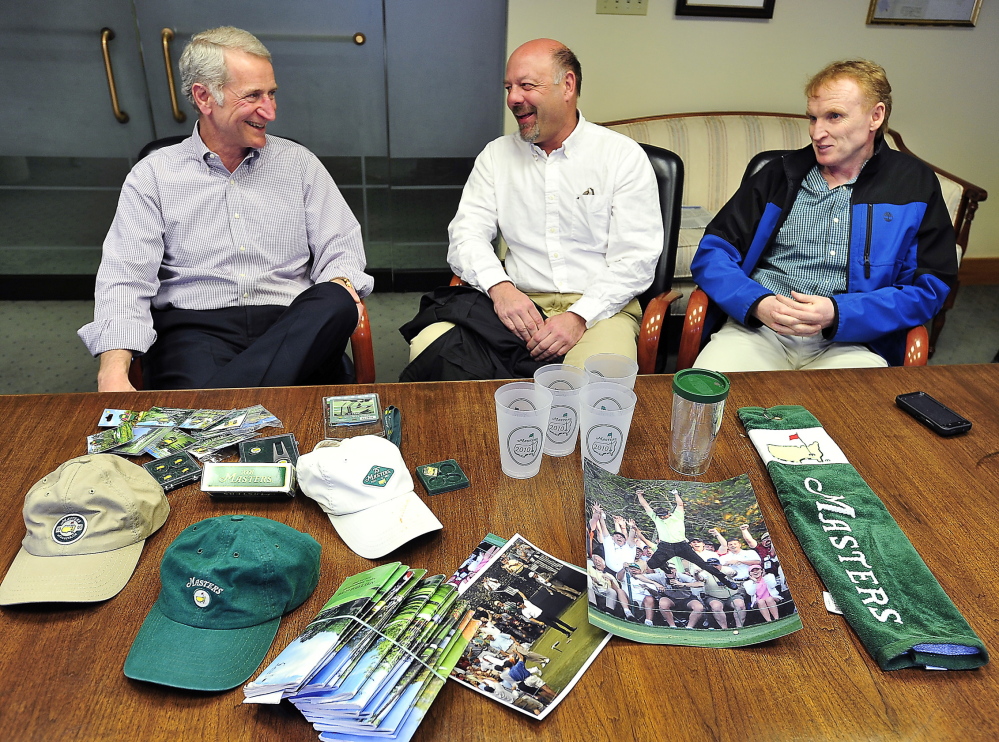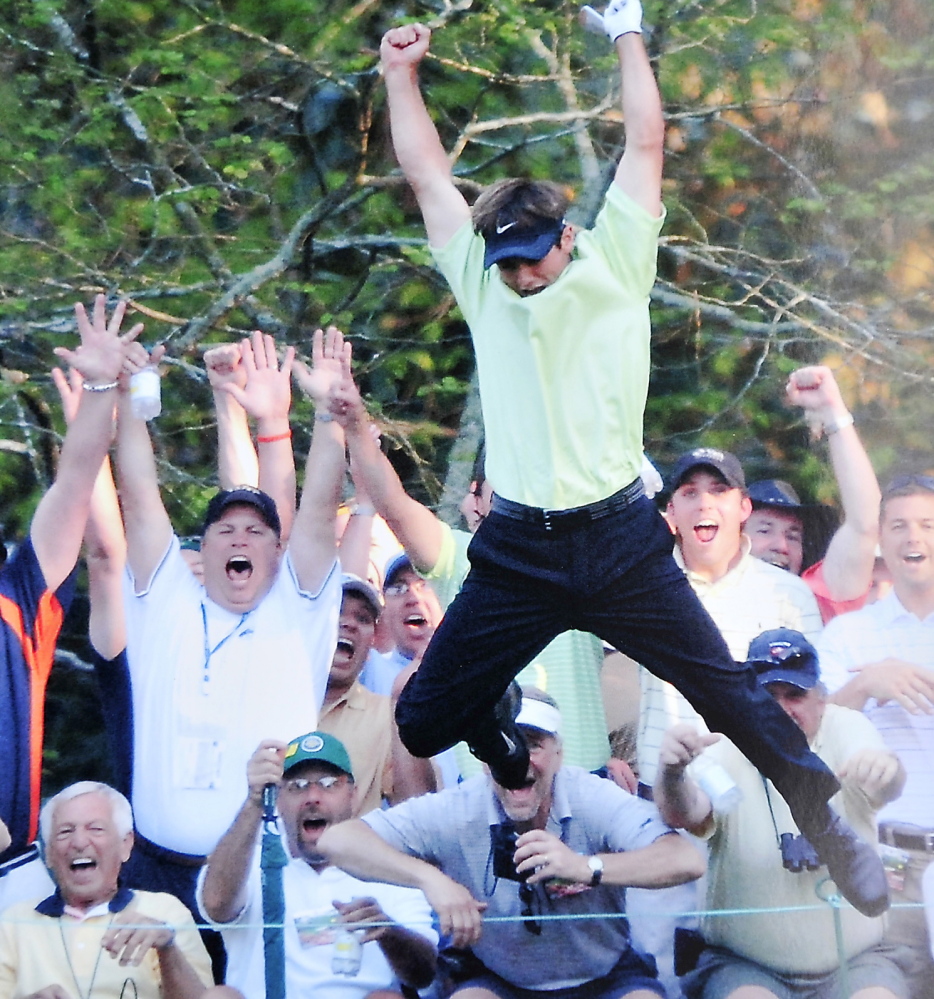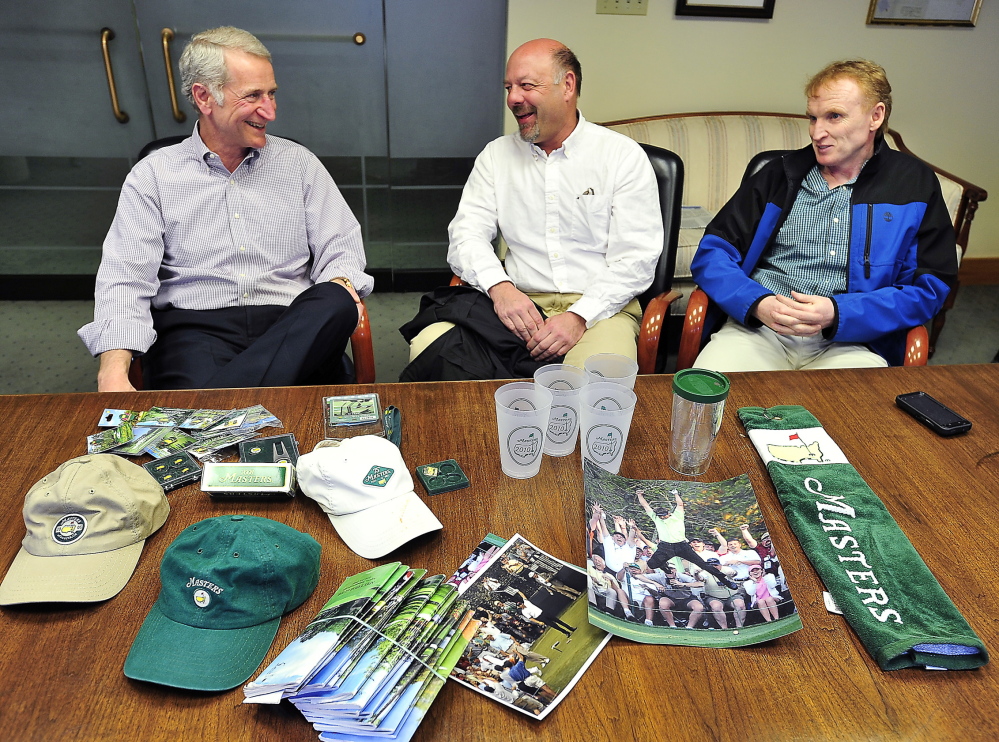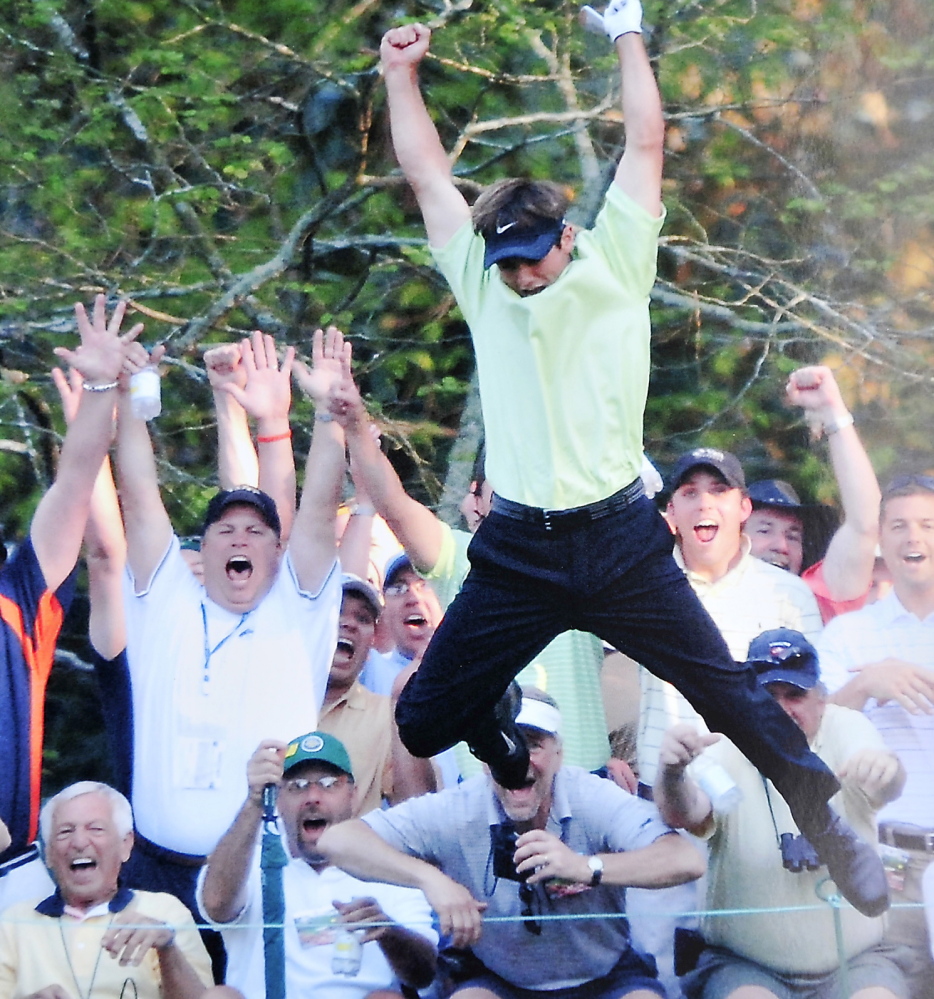A ticket to the Masters is one of the toughest to obtain in all of sports, yet three southern Maine men have made the pilgrimage to Augusta, Ga., for years.
While golf fans will be glued to their televisions starting Thursday for the first major of the year, Scott Brown, David Ray and David Chipman will have front-row seats at Augusta National Golf Club.
Brown and Ray are lifelong friends. Chipman met them through mutual friends several years ago, and they’ve been golf partners ever since.
Brown, 51, an architect, and Ray, 61, a lawyer, live in Yarmouth. Chipman, 54, a contractor, lives in Brunswick.
Brown, who laid the foundation for the trips, has seen every Masters since 1992.
“I’ve been a golf fan for a long time and I always wanted to attend the Masters,” he said. “I had been to a lot of U.S. Opens and Ryder Cups and knew it was time to go.
“I had a real passion and I was going to make it work. I went down on my own the first time and managed to get in. I eventually met some of the right people. Being able to attend every year is based on the good friendships that I’ve developed over many years.”
This will be Ray’s 15th straight Masters and Chipman’s 12th.
The tickets are called Masters badges, which admit patrons to all four rounds.
The Masters has been sold out since 1972 and Augusta National has had a waiting list for badges since 2000. The face value of a badge is $250.
Of course, if a fan wants to dole out big bucks on the secondary market, it’s still possible to get into the tournament.
Earlier this week, Stubhub was offering a Thursday through Sunday package starting at $3,525.
A Thursday and Friday badge was $1,873 while a weekend badge was in the same price vicinity.
A Saturday ticket was going for $919 while on Sunday it climbed to $1,077.
And these prices are less than what they would have been if Tiger Woods were in the tournament this year. After Woods announced he will miss the Masters due to back surgery, prices dropped 20 percent on the secondary market.
By comparison, the face value for tickets to the Super Bowl in New Jersey ranged from $500 to $2,600.
The Masters doesn’t reveal attendance figures, but the crowds are approximately one-third of the 82,500 capacity of MetLife Stadium in East Rutherford, N.J.
“We’re very lucky,” Ray said. “Augusta National is pristine. Every time I go to the tournament, it’s a new experience. I absolutely love the tournament and watching it. There’s always something special that happens. It’s like you’ve walked into happy life. Everyone goes out of their way to make you feel at home.”
The three have witnessed some of the Masters’ iconic moments – Tiger Woods’ chip-in from behind the 16th green in 2005, Bubba Watson’s miraculous recovery shot from the trees on the 10th hole in a playoff two years ago, and Adam Scott’s winning putt last year, also in a playoff. And they’ve seen the final rounds of Arnold Palmer, Jack Nicklaus and Gary Player at Augusta.
They try to take in as much as they can, from the ceremonial tee shots hit by Masters legends like Sam Snead, Byron Nelson and Gene Sarazen of several years ago to Palmer, Nicklaus and Player now. Every year they attend the official awarding of the Green Jacket outside the clubhouse. Television viewers see a condensed version.
“The love for Palmer and Nicklaus at the Masters is incredible,” Brown said. “They helped to make the Masters and the Masters helped to make them.”
The Mainers have their routine down at Augusta National.
“We get there when they open the gates,” Ray said. “On Saturday we put our chairs by the 18th green. We have official Masters chairs that you can buy. We put our names on them. No one will remove them. Someone else might sit in it while we’re walking the course, but you just tap them on the shoulder when you return and they’ll get up. They’re very good at doing that.”
On Sunday they repeat the procedure behind the 16th tee. Those are their two favorite places and represent dramatic spots on the course.
“The 16th is exciting because a lot happens. I’ve seen three holes-in-one,” Ray said.
Another part of their routine is if there’s going to be a playoff, they head to the 10th hole, the second playoff hole, and position themselves behind it.
They even helped Greg Norman look for his tee shot with other gallery members after he hooked it off the 18th tee one year.
“I walked side-by-side with Norman for a few minutes while we looked,” Chipman said.
The golf course at Augusta National has gone through numerous changes. While it played under 7,000 yards in Palmer’s heyday during the 1960s, it now measures 7,435 yards.
“They added length during the Tiger-proofing period and after,” Brown said. “They’ve installed heating and cooling systems under some greens and have added a first and second cut to the rough. On the 11th hole they added trees down the right side. It used to be a bailout area on the tee shot. They moved the tee back. It’s gorgeous.”
What used to be a gravel parking lot is now the practice facility.
“It’s probably the best in championship golf,” Brown said.
Another change, Chipman said, is the seventh hole. It was a benign par-4 before the club added some teeth to it.
“The course seems to be evolving every year,” he said. “The greens have always been dramatic. The thing is, after they make the changes, the next year you go back, it seems like they have been there all along.
“There have been a lot of changes for the spectators, too. It’s made it easier for them to move around the course. There are more standing areas and raised areas to watch the tournament. Everyone gets a good perspective. There’s not a bad viewing spot on the course.”
One thing missing is the Eisenhower Tree down the left side of the 17th hole. It suffered severe damage from a February ice storm and was removed. The tree was named after the 34th president, who wanted it removed because he always kept hitting into it. As a result of the ice storm, several trees are missing.
As technology has changed the game, specificially with the clubs and balls, so has the need to add yardage so that technology doesn’t overtake the game.
“The athleticism of the players is so much improved,” Chipman said.
Brown and Chipman usually attend all four days of the tournament. Ray plans to attend on the weekend.
They stay in the same motel every year, which is only a little over a mile from the course.
Back home, Ray, a 20-handicapper, and Chipman, who plays to a 14, are regular players in a season-long skins game that is played at different courses. Brown, an 18 handicapper, will join them occasionally.
They will miss being able to watch Woods.
“Tiger not being there will put a damper on things,” Chipman said. “He’s definitely a magnet. But the Masters will be fine without him. There are so many good golfers stepping up.”
Added Brown: “The Masters will never let you down. There’s always a story that comes out of it and it will be a great story.”
The three man relish each and every trip to Augusta, knowing the string will end someday.
“We treat it like it could end any year,” Brown said.
Tom Chard can be reached at 791-6419 or at:tchard@pressherald.comTwitter: TomChardPPH
Send questions/comments to the editors.






Success. Please wait for the page to reload. If the page does not reload within 5 seconds, please refresh the page.
Enter your email and password to access comments.
Hi, to comment on stories you must . This profile is in addition to your subscription and website login.
Already have a commenting profile? .
Invalid username/password.
Please check your email to confirm and complete your registration.
Only subscribers are eligible to post comments. Please subscribe or login first for digital access. Here’s why.
Use the form below to reset your password. When you've submitted your account email, we will send an email with a reset code.